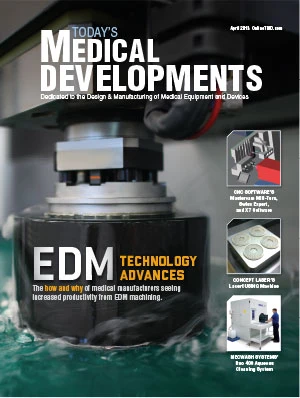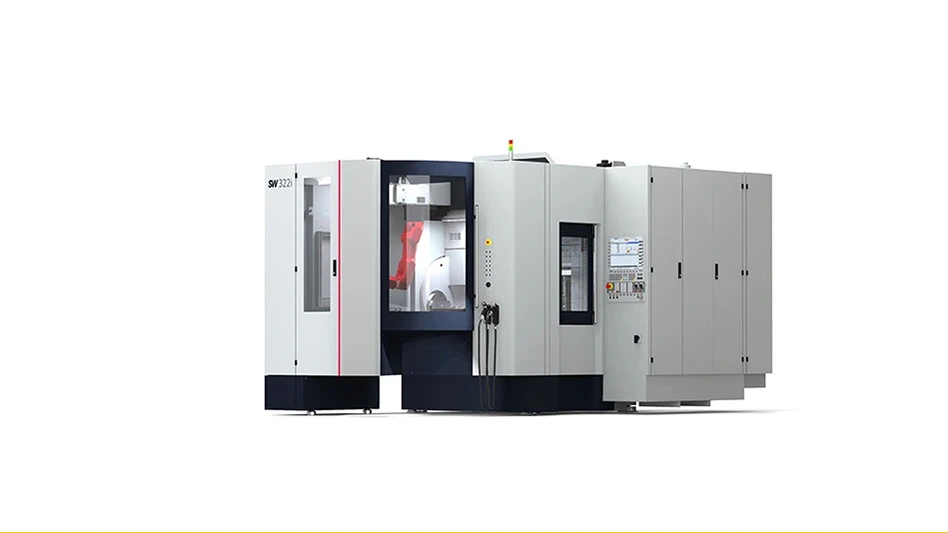 There have been recent advancements in the spark eroding process on Exeron Die Sinker EDMs, which increase cutting speeds and dramatically reduce electrode wear during roughing and finishing cuts. There have been recent advancements in the spark eroding process on Exeron Die Sinker EDMs, which increase cutting speeds and dramatically reduce electrode wear during roughing and finishing cuts. |
Medical manufacturers can successfully use EDM machining to make highly accurate, complex parts from very tough alloys, which are often extremely difficult to machine with traditional metal cutting techniques. As long as the material is conductive, the hardness/toughness of the material is a non-factor in the EDM process. In fact, generally the harder and more pure the material, the easier the material is to burn with EDM. Common materials used for medical component manufacturing include stainless, titanium, and cobalt chrome.
Another advantage of the EDM process is its ability to produce a part with small inside corners, which might not be possible with traditional end mills or cutting tools. EDMing is very efficient when manufacturing irregular shapes including tapered parts and stepped workpieces found in medical instruments, cut blocks, and femoral components. In addition, the use of EDM machining can see a savings cost in materials. Since the slot width made by the wire can be as small as 0.0015" wide, the large, unused portion of an expensive piece of material can be saved for future use versus turning it into scrap chips.
It is clear that EDM machining is an excellent choice for producing medical parts, with the process having seen many recent technology advancements and continuing to experience new developments.
Wire EDM
Beginning with a look at wire EDM, during the last several years much of the technology advancements have been in power supply and software technology to increase both cutting speeds and surface integrity. Power supplies can now support the use of specialized wires larger than 0.012" as well as new wire coatings such as zinc alloys. Power supplies have also been refined for better finishes in many different materials, which are difficult to machine conventionally. Controller software advancements have led to increased straightness in taller work, more precise corners, and improved finishes.
Advances in pulse control technology enable high-speed, high-precision cutting and optimize cutting speeds even on stepped, multi-level, or irregularly shaped parts. Using the latest in pulse control, users can accurately count the number of effective discharge pulses and maximize cutting speed without sacrificing precision. Uniform energy density and discharge gap can be ensured, and discharge-monitoring cycles are up to four times faster than that of conventional machines.
 The FANUC RoboCut C600iA Wire EDM has several important upgrades including the FANUC 31iWB control, which is loaded with features for improved accuracy and finish, especially in high-taper 4-axis cutting. The FANUC RoboCut C600iA Wire EDM has several important upgrades including the FANUC 31iWB control, which is loaded with features for improved accuracy and finish, especially in high-taper 4-axis cutting. |
Today’s anti-recast power supplies provide virtually undetectable recast at 1,000:1 magnification in high nickel alloys with similar results in stainless and titanium materials at 50:1 magnification. Moreover, excellent circularity is possible with digital pulse control technology combined with nano interpolation fiber optic cabling to enable smooth axis motion, even at high speeds. For example, the Ai Pulse Control II from FANUC (Methods Machine Tools is the exclusive North American importer of FANUC Wire EDMs) now offers better straightness and faster cutting speeds for both roughing and finishing in interrupted cuts.
Auto threaders have been optimized to provide flawless, submerged 10-second (or less) threading and precise wire tension control. The latest auto threader annealing technology ensures threading up to 16" tall workpieces and allows threading through the gap after a wire break. This capability eliminates the need to return to the start hole to re-thread the wire, resulting in reduced cycle time and improved unattended operation.
The FANUC Auto-Threader features technology that prevents curl at the wire tip during the wire cut process of the threading cycle. This provides enhanced reliability when threading soft wire while submerged and in the cutting gap.
Now, wire EDM equipment is capable of better finishes, more accuracy, and virtually no-recast. Changes in the wire EDM market have been refined, squeezing out every micron of a machine’s capability to increase productivity. Along with cutting enhancements, machine tool builders are also focusing on green operation. For example, FANUC has designed controls with the ability to monitor electrical usage and manage the use of its components more efficiently, powering down certain electrical components that are not needed, thus saving overall electrical consumption by up to 20%. Interfaces are also improving ease-of-operation with larger LCD touch screen and streamlined menu keys.
Automation is another area in which wire EDM manufacturers are helping medical manufacturers increase productivity and improve workflow. Automation control systems have evolved to the point where wire EDM operators can machine parts of different sizes with one setup. Expanding the number of possible unattended operations allows manufacturers to maximize operating times without increasing labor costs, which has a positive effect on the bottom line.
Die Sinker EDM
Die sinker EDM technology is also very well suited for medical component manufacturing. Throughout the United States, CNC die sinkers are being utilized to burn unique features in implants, such as the hex shape in the end of bone screws, and opening up difficult to machine blind passages in instrumentation.
 Top: Shown is a saw guide used in knee replacement surgery that was cut on a FANUC RoboCut CiA Wire EDM. Bottom: An irregular tapered workpiece was produced with precision on a FANUC Wire EDM. Top: Shown is a saw guide used in knee replacement surgery that was cut on a FANUC RoboCut CiA Wire EDM. Bottom: An irregular tapered workpiece was produced with precision on a FANUC Wire EDM. |
There have recently been breakthroughs in the spark eroding process for some die sinker EDMs, which increases cutting speeds and dramatically reduces electrode wear during roughing and finishing cuts, resulting in medical parts that are more accurate. For optimal efficiency and performance, the spark eroding technology features an innovative, compact power source design (about the size of a notebook computer) which minimizes energy usage and sheds only a small amount of heat. The liquid-cooled power supply dissipates heat completely, ensuring that the temperature level of the electronics remains constant and the machining process is stable and repeatable.
New power supplies are tremendously energy efficient. To achieve compact stature and efficiency, a unique, liquid cooled heat exchanger is integrated into the aluminum framework that holds the power generation board. The coolant used to dissipate heat in the power supply is simply the dielectric fluid already available in the machine. A small pump is included in the machine’s dielectric system that continually circulates filtered dielectric oil directly from the chiller to the power supply and back to the machine reservoir. This consistency of the cooling provides for a very stable machining process, while allowing the machine cabinet that houses the power supply to be completely sealed from outside contaminants.
This design allows for years of life with little to no operator maintenance. It also eliminates the need for circulation fans, which are prone to failure over time, and draws additional electrical current. These new power supplies operate at cooler temperatures, resulting in improved input voltage stabilization.
Improvement in efficiency also comes from reducing the cable lengths required to go from the power supply to the head of the machine. By reducing the size of the power supply, the unit can be located closer to the machine head and table to improve current transfer and grounding. The simplistic design of the power supply reduces the need for the number of boards required, and with fewer boards to contend with, overall reliability of the power supply is improved. For example, Methods Machine Tools, Inc. offers Exeron GmbH die sinker EDMs, which include new exopuls+ liquid cooled generator technology, providing all of the benefits for diesinker technology stated earlier.
Fast Hole EDM Drilling
Additionally, fast hole EDM drilling machines, including those from Current EDM (distributed by Methods Machine Tools, Inc.), can be used to efficiently manufacture small, tight tolerance holes in medical parts that require the insertion of suture material and guide wires. Recent enhancements in this technology include controller and power supply upgrades. Software and hardware upgrades to the controller and EDM power supply improve drilling speed and stability, while reducing electrode usage and improving metallurgical recast issues.
New power supply technologies enable drilling with less side-wear at the tip of the electrode. This results in more consistent hole depth and diameter, faster drilling speeds, and more holes per electrode. In an effort to reduce cycle time, automatic electrode changers have also been upgraded to shorten electrode change time and optimize electrode usage, leading to fewer overall electrode changes.
 A twisted step details the precision capable of a FANUC Wire EDM. A twisted step details the precision capable of a FANUC Wire EDM. |
New servo controls with advanced gap sensing improve drilling stability and reduce electrode flexing, especially when using longer, small diameter electrodes. In addition, new TRACE functions further the ability to optimize depth control by providing a graphical method to fine-tune depth sensing when drilling into small pockets.
A Look Ahead
More and more manufacturers, not only in medical but throughout a wide variety of manufacturing industries, are exploring automation to reduce the labor costs and increase spindle run times. Advanced automation solutions, which combine several technologies such as EDM, 5-axis high-speed milling, and in-process inspection, can be highly efficient. These advanced automation solutions include the ability to transfer parts across a multitude of machining platforms in an effort to reduce total cycle time by minimizing handling and maximizing efficiencies.
Many medical manufacturers already run quite lean as it relates to labor, so they need solutions to increase production and further reduce delivery time with their current labor force. Key objectives include combining machining platforms, reducing handling, changeover time, and inspection, all while maximizing spindle runtime.
EDM technology will continue to evolve with more automated solutions to reduce labor. Automating the process, improving the software to allow for a diverse work load, both in material types and workpiece sizes, is where manufacturers will be focusing their time on refining the integration of robots. Quicker set-ups and easier operation are critical when there is a reduction in labor for saving money to produce parts.
Methods Machine Tools, Inc.
Sudbury, Mass.
www.methodsmachine.com
To view a FANUC RoboCut CiA Wire EDM cutting a slot in a saw guide used in knee replacement surgery visit http://bit.ly/Wa5BCL.

Explore the April 2013 Issue
Check out more from this issue and find your next story to read.
Latest from Today's Medical Developments
- Tariffs threaten small business growth, increase costs across industries
- Feed your brain on your lunch break at our upcoming Lunch + Learn!
- Robotics action plan for Europe
- Maximize your First Article Inspection efficiency and accuracy
- UPM Additive rebrands to UPM Advanced
- Master Bond’s LED415DC90Med dual-curable adhesive
- Minalex celebrates 60 years of excellence in miniature aluminum extrusions
- Tormach’s Chip Conveyor Kit for the 1500MX CNC Mill





